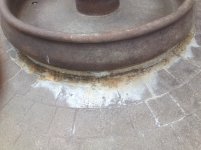chrishartje
New member
Craig, can you give me detailed instructions on the proper way too address these two different scenario's with f-9 c&e remover?
Suggested mix ratios
Estimated dwell times
Neutralizing
Anything that would help in the restoration!
1st pic fertilizer and calcium staining.

Sent from my iPhone using Tapatalk
Suggested mix ratios
Estimated dwell times
Neutralizing
Anything that would help in the restoration!
1st pic fertilizer and calcium staining.

Sent from my iPhone using Tapatalk




